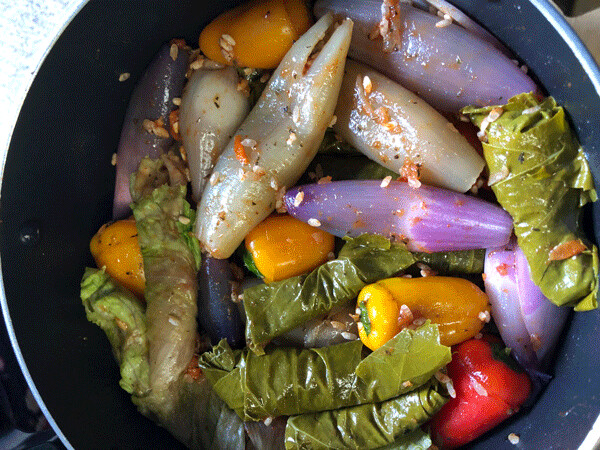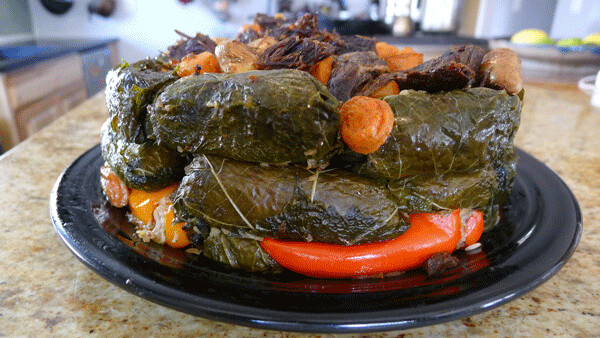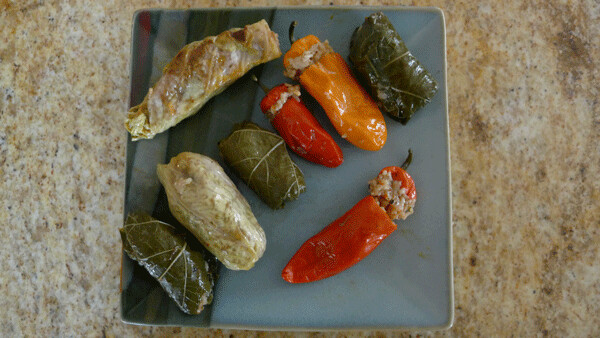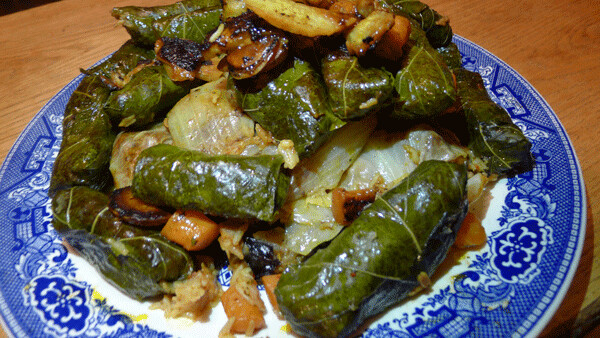News & Articles
Browse all content by date.

In the small kitchen of a pale green trailer adorned with American flags and Easter eggs, a pot of dolmas rested on a stovetop, swaddled in towels. My dolma instructor, who made them, came to the U.S. with her family six years ago from Mosul, Iraq. I had eaten dolmas before, or so I thought. When I first tried hers, it felt like an awakening.
“Dolma” is a busy word. It comes from the Turkish dolmak, which means “to fill.” It’s an appropriately general name, given a wide dolma diaspora that includes sweet, sour and salty incarnations. Best known are the Mediterranean-style grape leaves filled with plain, lemony rice, but the word “dolma” can also refer to a nut-filled apple in northern India, or a bulgur-stuffed eggplant in Turkey.
In spite of this diversity, somehow the name itself has remained unchanged, from Crete to Tbilisi. As long as something is filled with something, it’s a dolma.
My dolma instructor had shown me the Mosulian way to prepare the rice, fill the dolmas, and cook them. Now it was time for the grand finale. She placed a metal platter atop the dolma pot, upside down so the dolmas would sit on the platter right-side-up when it was inverted. With one hand below the pot and the other pressing down on the platter, she lifted everything above her head, deftly flipped the whole assembly, and placed it gently on the table, like a pool shark racking up cue balls in 3D. She gave the pot a quick spin left and right, slapping it with a few beats in between, and lifted it, revealing a perfectly round tower of dolma.

Stuffed grape leaves formed the bulk of the structure, but it also contained sweet peppers, rolled cabbage and onions, hollowed out zucchini, and feisty jalapenos, all filled with spicy tomato rice and capped with caramelized garlic, cauliflower and carrots.
Her daughter translated, and discussed this upper layer of browned goodness, which she referred to simply as “bottom.” Composed of any number of vegetables or meats, it cooks in the lemony juices of the dolma pot, and then migrates to the top at serving time.
Daughter, statuesque with curly hair, calls the whole presentation a “shape.” “There are many shapes,” she said, while scrolling through images of freshly-flipped pots of Iraqi dolmas on her phone. She paused on a photo with a bottom of lamb chops and fava beans atop the dolma tower. “That one is cute,” she said.

My dolma instructor shook the tower of dolma, and it collapsed into a steaming heap of color and flavor. The rice was cooked, yet on the dry side. The plump dolma glistened, bursting with a tangy, sour flavor that was spicy but smooth, with no single element jumping out as dominant.
Making dolmas that an Iraqi will respect is hard. If you don’t use the right amount of water, or pack them correctly in the pot, or cook them properly, the shape will crumble and scatter. Worse, the dolma can be soggy, with tough, fibrous grape leaves. Maybe they fall apart and scatter rice everywhere, and the bottom can blacken beyond recognition. But I’d take my worst attempt at an Iraqi dolma over any other dolma I’d eaten before my apprenticeship. Those green finger clones in the deli case, little more than starchy mush wrapped in frail grape leaves, are empty calories to me now.
Iraqi dolmas usually have tomato sauce mixed in with the rice. This Mosul-style recipe is distinct in its use of mint instead of the parsley that’s more common in Iraq. But the real secret, daughter says, “is how we balance the salt, sour, and water.”
I watched them make the dolmas in front of me, and took copious notes, and still it took me many attempts to get it right in my dolma pot, on my stove, with my brand of rice. But it’s worth the effort. The rich and satisfying rewards of this Old World treat never get old.

Mosulian Dolmas
The actual rolling and stuffing of the grape leaves and veggies is difficult to convey in words alone. There are videos and tutorials to be found online for each type of veggie you could make into a Musulian dolma.
Once you get the hang of filling vegetables with Iraqi dolma rice, you will be ready to make them with almost anything your garden can grow. Grape leaves will always be the anchor of my dolma pot, the mortar that holds the shape together. But mixing in an assortment of stuffed veggies, and playing around with the bottom/top, add diversity and balance to the dolma pot.
Serves ten
½ cup grated potato
½ cup grated carrot
½ cup thinly-sliced onion
2 cloves of garlic, minced
3 cups white rice
6 teaspoons dried mint
2 tsp salt
2 tsp pepper
1 tsp paprika
1 tsp hot chile powder, like Allepo
or Cayenne
1 tsp cinnamon
1 can tomato sauce
A cup or so of bottom ingredients, either vegetables, meat, or some combination
1 cup lemon juice
1 cup olive oil
Fry the potato, carrot, onion and garlic in 3 tablespoons olive oil on medium heat until everything is shriveled and golden. Set aside.
Rinse the rice in a bowl by adding water, swishing it around, draining, and repeating until the water stays clear. Drain.
Add 1 teaspoon of salt, all of the dried spices, the fried veggies and the tomato sauce to the rice. Mix well.
Place bottom ingredients loosely about the bottom of the pot. Fill the dolmas-easier said than done-and stack them in the pot, interlocking the pieces so as to help hold the structure together.
When the dolmas are filled, add a teaspoon of salt to the pot, followed by the lemon juice, the rest of the olive oil, and about ½ cup of water-or until the water level is about an inch beneath the top of the dolmas. Cook on medium for about 45-60 minutes, watching for when the water disappears, and smelling for the line between browned and burned. Swaddle with towels on the stove, and let it rest for 20 minutes. Invert and serve.
| Tweet |


